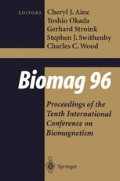Abstract
In view of the eminent importance models have for the interpretation of biomagnetic data, it is a matter of concern that a generally accepted strategy for the analysis of experimental data is not in sight. It seems evident that the future prospects of biomagnetic investigations as compared to other functional imaging techniques (e.g. PET, fMRI) will decisively depend on the success of new data analysis techniques. The necessity to develop new modeling strategies is underlined by the fact that the availability of whole-head magnetometer devices necessitates the development of better models: First, more realistic volume conductor models are required, because simple models like a homogeneous sphere are not capable of providing a good approximation if the measurement area Covers the whole head rather than a relatively small area. Second, the number of sources to be considered generally increases with increasing measurement area so that simple source models like the equivalent current dipole become more and more obsolete.
Access this chapter
Tax calculation will be finalised at checkout
Purchases are for personal use only
Preview
Unable to display preview. Download preview PDF.
References
Crowley, T., Haupt, C., and Kynor, D. A weighting matrix to remove depth bias in the linear biomagnetic inverse problem with application to cardiology (this volume).
Dale, A. and Sereno, M. Improved localization of cortical activity by combining EEG and MEG with MRI cortical surface reconstruction: a linear approach. J. Cognit. Neurosci., 1993, 5: 162–176.
Forss, N., Hari, R., Salmelin, R., Ahonen, A., Hämäläinen, M., Kajola, M., Knuutila, J., and Simola, J. Activation of the human posterior parietal cortex by median nerve Stimulation. Exp. Brain Res., 1994, 99: 309–315.
Greenblatt, R. Probabilistic reconstruction of multiple sources in the bioelectromagnetic inverse problem. Inverse Problems, 1993, 9: 271–284.
Hämäläinen, M. and Ilmoniemi, R. Interpreting measured magnetic fields of the brain: Estimates of current distributions. Technical Report TKK-F-A559, Helsinki University of Technology, Helsinki, 1984.
Hansen, P. Regularization tools, a Matlab package for analysis and Solution of discrete ill-posed problems (available in postscript from http://www.mathworks.com/), 1993.
Huotilainen, M., Ilmoniemi, R., Tiitinen, H., Lavikainen, J., Alho, K., Kajola, M., and Näätänen, R. The projection method in removing eye-blink artefacts from multichannel MEG measurements at the site of pain. In Baumgartner, C., Deecke, L., Stroink, G., and Williamson, S., editors, Biomagnetism: Fundamental Research and Clinical Applications, pages 363–367, Amsterdam, 1995. Elsevier Science, IOS Press.
Ilmoniemi, R. The projection method in magnetoencephalography. Finnish patent application No. 925461, Nov. 30, 1992. International patent application No. PCT/F193/00504, Nov. 30, 1993.
Ilmoniemi, R. and Williamson, S. Analysis for the magnetic alpha rhythm in signal space. Soc. Neurosci. Abstr., 1987, 13 (2): 46.
Ilmoniemi, R., Williamson, S., and Hostetier, W. New method for the study of spontaneous brain activity. In Atsumi, K., Kotani, M., Ueno, S., Katila, T., and Williamson, S., editors, Biomagnetism ‘87, pages 182–185, Tokyo, 1988. Tokyo Denki University Press.
Lütkenhöner, B., Greenblatt, R., Hämäläinen, M., Mosher, J., Scherg, M., Tesche, C., and Valdes Sosa, P. http://hobbes.uni-muenster.de/SantaFeWorkshop1996 ( Homepage of the Santa Fe 1996 Modeling Workshop).
Mosher, J. Subspace angles: A metric for comparisons in EEG and MEG (this volume).
Mosher, J. and Leahy, R. Music recursively applied to the generation of source models in EEG and MEG (in preparation).
Mosher, J., Lewis, P., and Leahy, R. Multiple dipole modeling and localization from spatio-temporal MEG data. IEEE Trans. Biomed. Eng., 1992, 39: 541–557.
Pascual-Marqui, R., Michel, C., and Lehmann, D. Low resolution electromagnetic tomography: a new method for localizing electrical activity in the brain. Int. J. Psychophysiol., 1994, 18: 49–65.
Sakamoto, Y., Ishiguro, M., and Kitagawa, G. Akaike Information Criterion Statisiics. Tokyo, KTK Scientific Publishers, 1986.
Scherg, M. Functional imaging and localization of electromagnetic brain activity. Brain Topography, 1992, 5: 103–111.
Scherg, M. and von Cramon, D. Two bilateral sources of the late AEP as identified by a spatio-temporal dipole model. Electroenceph. clin. Neurophysiol., 1985, 62: 32–44.
Tesche, C., Uusitalo, M., Ilmoniemi, R., Huotilainen, M., Kajola, M., and Salonen, O. Signal-space pro-jections of MEG data characterize both distributed and well-localized neuronal sources. Electroenceph. Clin. Neurophysiol., 1995, 95: 189–200.
Tesche, C., Uusitalo, M., Ilmoniemi, R., and Kajola, M. Characterizing the local oscillatory content of spontaneous cortical activity during mental imagery. Cog. Brain Res., 1995, 2: 243–249.
Uusitalo, M. The projection method in magnetoencephalography. Sc. thesis, Helsinki University of Technology (in Finnish ), 1993.
Uutela, K., Hämäläinen, M., and Salmelin, R. Global optimization in the localization of brain activity (this volume).
Wahba, G. Spline Models for Observational Data. Philadelfia, Society for Industrial and Applied Mathematics, 1990.
Author information
Authors and Affiliations
Editor information
Editors and Affiliations
Rights and permissions
Copyright information
© 2000 Springer Science+Business Media New York
About this paper
Cite this paper
Lütkenhöner, B. et al. (2000). Comparison between different approaches to the biomagnetic inverse problem — workshop report. In: Aine, C.J., Stroink, G., Wood, C.C., Okada, Y., Swithenby, S.J. (eds) Biomag 96. Springer, New York, NY. https://doi.org/10.1007/978-1-4612-1260-7_41
Download citation
DOI: https://doi.org/10.1007/978-1-4612-1260-7_41
Publisher Name: Springer, New York, NY
Print ISBN: 978-1-4612-7066-9
Online ISBN: 978-1-4612-1260-7
eBook Packages: Springer Book Archive

